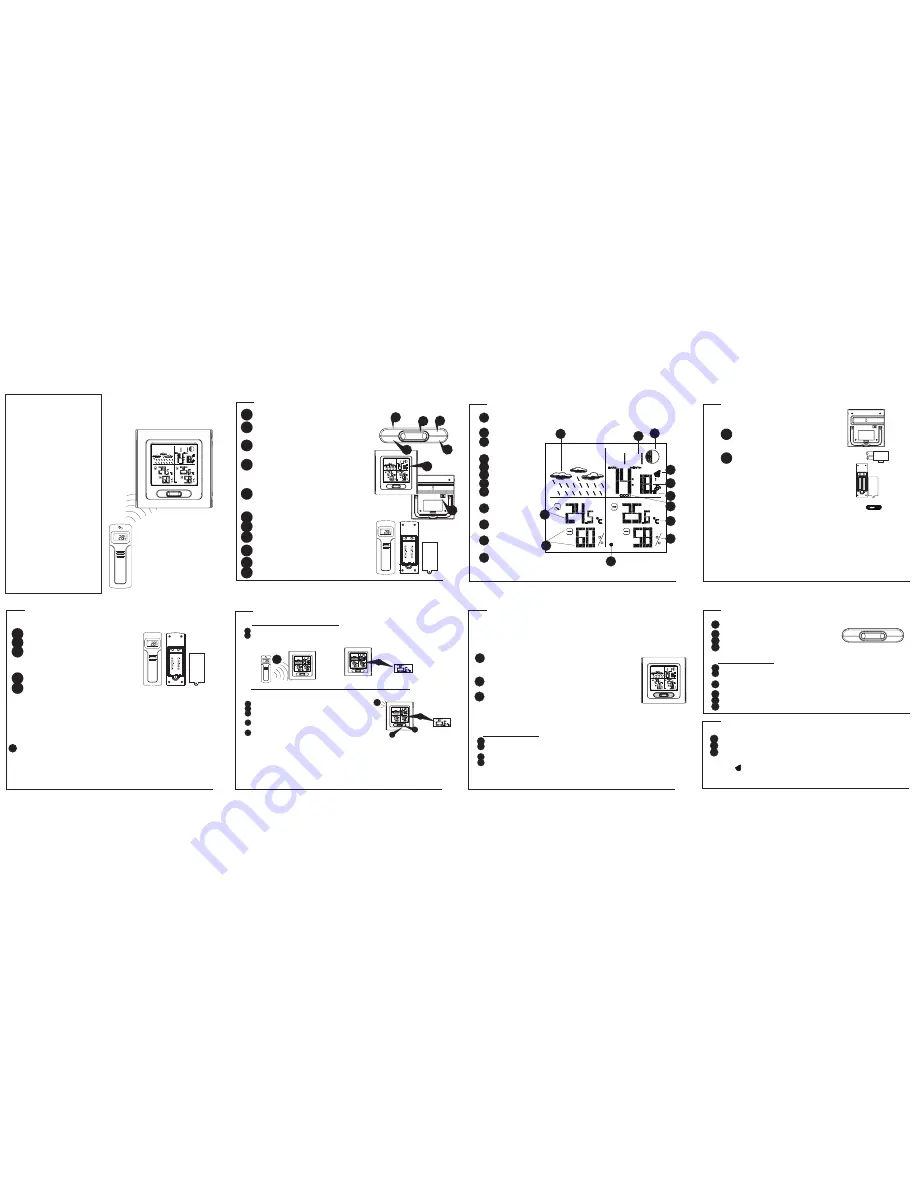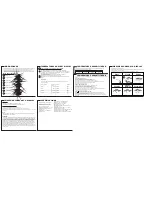
LAYOUT
GARNI
1233+WT450H
Instruction Manual
FEATURES
WT450H
remote sensor
GARNI
1233
receiver
Feature of
GARNI
1233
* Dual band RCC. (DCF77 / MSF)
*
Clock display
*
12/24 Hour clock display mode
*
2 Alarm clock
*
Month, Date and Weekday display in 5
language, included (English, Dutch,
Italian, Spanish & French)
*
Moon phase display
*
Temperature indoor/outdoor
*
Humidity indoor/outdoor.
*
Temperature, Humidity Trends
*
Low battery display
*
Temperature & Humidity Max/Min record.
*
Temperature Display in C or F unit.
*
Animated weather forecast
*
12-hour pressure history bar graph.
*
High/Low temperature alarm.
*
3 remote channels.
*
LED Back light.
Remote Sensor WT450H:
* Splash proof design with LCD
* Temperature display in user-selectable C
or F
* Humidity display
* Transmission range: up to 40 meters
* Battery: 2 x AA size
1. Weather forecast
symbol.
2. Moon phase display.
3. Weekday, date,
month display.
4. Time display.
5. Alam 1/2 icon.
6. RCC icon.
7. Clock 1/2.
8. Outdoor temperature
and trend.
9. Outdoor humidity
and trend.
10. Remote channel
1,2,3 and 4.
11. Indoor temperature
and trend.
12. Indoor humidity and
trend.
Mode:
scrolls through Clock 1 & 2, Alarm 1 & 2, and
Temperature Alarm (high & low) mode.
Hour/+:
shows maximum/minimum temperature;
adjusts clock, alarm, date & year and temperature alarm
values.
Min/-:
Adjusts clock, alarm, date & year and tempera-
ture alarm values. Switch Weekday, date/month and
year display
Chn:
scrolls through remote channels Outside 1,
Outside 2 and outside 3); scrolls through local and
remote channels (Outside 1, Outside 2 and Outside 3)
in (Max & Min) temperature alarm mode; activates the
learning procedure.
Snooze:
Select Week/day language, toggles between
12 and 24 hour format, Alarm 1 & 2 On and Off;
disables (resets) high & low temperature alarms; Alarm
snooze. Select C/F temperature display
Main LCD display with Green backlight.
Dual band switch for DCF MSF selection.
SET: enter into setting mode and confirm the values
during setting.
C/F: change value of channel and house code during
setting. Select between C or F.
Battery compartment
LCD display
1
6
8
9
10
11
2
3
4
5
7
Hour/+
Mode
Channel
Minute/-
Snooze
MOON PHASE
FORECAST
TEMPERATURE
HUMIDITY
TEMPERATURE
HUMIDITY
I
N D O O R
O
U T D O O R
MOON PHASE
FORECAST
TEMPERATURE
HUMIDITY
TEMPERATURE
HUMIDITY
I
N D O O R
O
U T D O O R
MOON PHASE
FORECAST
TEMPERATURE
HUMIDITY
TEMPERATURE
HUMIDITY
IN D O O R
OU T D O O R
1
5
2
3
4
6
7
1
2
1
2
3
4
SETUP
Automatic Learn Function:
Manual-Learning (Searching for Remote Signals)
1
*
MOON PHASE
FORECAST
TEMPERATURE
HUMIDITY
TEMPERATURE
HUMIDITY
IN D O O R
OU T D O O R
MOON PHASE
FORECAST
TEMPERATURE
HUMIDITY
TEMPERATURE
HUMIDITY
IN D O O R
OU T D O O R
Learn function executes automatically and runs for approximately 3 minutes when the
batteries are first installed in the receiver.
Within these 3 minutes, the receiver picks up the temperature & humidity signals from the
remote sensor and displays the readings.
2
If a new remote sensor is added or if the signal is lost (outdoor display blinking), the learning
function must be executed again.
Press and hold CHN for 3 seconds to start.
A beep sound indicates that the learning function has started.
The 'Channel' symbol will flash and unit will beep as each remote
sensor is detected.
Temperature & humidity readings of remote sensor are displayed
on the receiver.
Fixing your remote sensor and receiver
The remote sensor has a wall mount holder. To fix it on a wall, fix
the holder on a hook or nail. The remote sensor should be fixed
on a smooth surface to prevent altering the range of the date transmission. To ensure a good
transmission, the remote sensor should not install on or near a large metal surface. Before
choosing the location of the remote sensor, test that the receiver can receive the signals. It is also
recommended that the remote sensor is placed as close as possible to the receiver to eliminate
any interference. The receiver also has a wall mount holder and a stand. To place it, use the same
precautions as for the remote sensor.
Backlight:
The default state of the Backlight is Off. To turn the backlight on, press any button. It will stay on
for about 10 seconds.
MOON PHASE
FORECAST
TEMPERATURE
HUMIDITY
TEMPERATURE
HUMIDITY
IN D O O R
OU T D O O R
4
Hour/+
Mode
Channel
Minute/-
Snooze
1
3
2
Clock 1 setting
CLOCK AND DATE SETTINGS
1
i
2
ii
3
iii
iv
MOON PHASE
FORECAST
TEMPERATURE
HUMIDITY
TEMPERATURE
HUMIDITY
IN D O O R
OU T D O O R
Hour/+
Mode
Channel
Minute/-
Snooze
RADIO CONTROL CLOCK
The WS1233 is designed to automatically synchronize its calendar clock once it is brought within
the reception range of a radio signal. There are 2 different radio signals:
-
DCF77 signal, for GMT +1 (France, Spain, Italy, Germany);
-
MSF signal, for GMT (UK, Ireland, Portugal).
The DCF77 signal will be received if the main unit is within 1500 km of the Frankfurt atomic clock.
Your main unit will be automatically synchronized with the MSF signal if located within the UK radio
signal range.
The clock automatically starts scanning the RF 433MHz signal after new
batteries are inserted in the main unit. When receiving radio signal, the
Radio Tower symbol starts to blink. A complete reception generally takes
several minutes, depending on the strength of the radio signal. The scan
can also be triggered manually by holding the Min/- key for 3 seconds.
When the reception is complete, the Radio Tower symbol will stop blinking
and remain solid. The clock automatically scans the time signal at 02:07
everyday to maintain accurate timing.
If the clock is within the range of both the DCF77 and MSF radio signals,
you can toggle between the 2 signals by sliding the DCF/MSF RCC key.
Notes:
•
For an optimal reception, place the clock away from metal objects and electrical
appliances (i.e. television, computer, monitor, etc.) to minimize interference.
•
If the user sets the time (year/month/date/hour/minute) manually, the unit will stop
receiving the radio control clock signals.
Press Snooze key on Clock 1 mode to alternative between the 12 and 24 hour display.
Press and hold mode for 3 seconds to enter the clock setting mode (the CLOCK 1 symbol will
appear, and the time will flash).
Press Hour/+ to set the hour and Minute/- to set the minutes.
Press Snooze during the clock settings to select the language of week/day display.
Note:
•
If you do not press any key for one minute, the clock will accept the last settings entered.
•
February will have either 28 or 29 days. Your weather station will display the 29th day on
bissextile years.
Clock 2 Settings (Dual Time)
CLOCK AND DATE SETTINGS
ALARM SETTING
1
2
i
ii
3
1
2
3
4
1
2
3
4
Hour/+
Mode
Channel
Minute/-
Snooze
DATE/MONTH/YEAR SETTING
After clock 1 is set, press Mode to accept the time settings. Upon pressing mode, the
month and date will flash.
Press the Hour/+ to set the month.
Press the Minute/- to set the date.
Press Mode, the year will flash. Press the Hour/+ to move the year upwards and
Minute/- to move the year downwards. Press Mode to confirm all your settings.
Scroll to Clock 2 using Mode.
Press + or – key to change the hour (in hour increments/decrements relative to Clock 1).
Other settings of clock display
Press "Hour/+" on clock 1 mode shows maximum/minimum temperature, press
"Hour/+" for 3 seconds resets maximum/minimum temperature record.
Press "Minute/-" on clock 1 mode switches the weekday/Date month/Year display.
Press "Snooze" on clock 1 mode to switch the 12/24 hour time format.
Press "Snooze" on clock 2 mode switches the C/F display.
Alarm Setting
Scroll to Alarm1 mode (Alarm2 mode) using MODE
Press HOUR/+ to set the hour.
Press MIN/- to set the minutes.
Press Snooze to toggle alarm on and off. When the alarm is set ON, the Unit will emitted a
sound.
When Alarm Sounds
a.
will flash.
b.
Press Snooze to snooze the alarm for 5 minutes. After that the alarm will sound again.
c.
Press ANY other key to turn the alarm sound off. If not manually interrupted,
the alarm sound will automatically stop after one minute.
DISPLAY LAYOUT
POWER SUPPLY
2
1
+
-
+
-
SET
C/F
A
A
1.5V
A
A
1.5V
LOW BATTERY INDICATION:
If the batteries of the remote sensor are low, the following indicator . will be
displayed on the main unit. The indicator will also be displayed on the bottom left corner
of the remote sensor’s screen. When the main unit’s LCD display becomes dim, it
indicates that the batteries are low and need to be changed.
Note:
if the sensor is exposed to very low temperatures for an extended period of time,
the batteries may lose power which may cause the transmission range to be limited.
High temperatures also reduce the battery performance.
DCF
MSF
GETTING STARTED
Setting remote sensors
Press
SET
to start
House code will flash for 10 seconds.
Select house code (1-15) by pressing C/F key.
Press
SET
to confirm.
Remote sensors for each receiver must be set
to the same house code.
Channel will flash for 10 seconds.
Select channel(1-3) by pressing C/F key.
Press SET to confirm.
* Use a different house code if your weather station det ects other signals
from neighbouring sources.
* Factory default: house code = 01 and channel = 01
Setting the Main unit
Remove battery cover and insert 2xAA size batteries, ensure correct polarity
+ / - as shown in the compartment, replace the cover.
1
1
2
3
4
5
Weather Station works with 2 AA batteries for the main
unit and 2 AAA for the remote sensor (all not included).
Battery installation
Main Unit: Use your finger to lift the battery door
located at the back of the main unit. Insert 2 AA
batteries according to the polarity. Close back the
battery compartment.
Remote Sensor: Use a screwdriver to open the
battery door located at the back of the remote
sensor unit. Insert 2 AA batteries according to the
polarity. Close back the battery compartment and
tighten the screw.
1
1
2
2
3
3
4
4
5
5
6
6
7
7
8
8
9
9
10
10
11
11
12
12
1
4
5
6
7
2
3




















